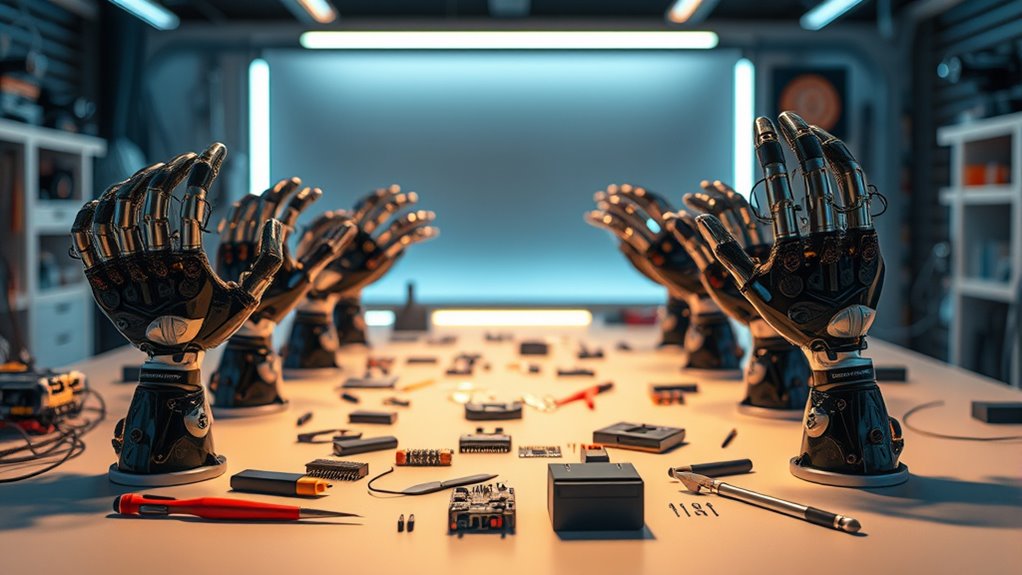If you’re looking for the 15 best robotic hand kits for makers and enthusiasts in 2025, I recommend exploring options that cover a range of skills and complexity. From beginner-friendly mechanical and hydraulic kits to advanced programmable robotic arms with Arduino and AI features, there’s something for everyone. Materials vary from wood to acrylic, and some kits focus on STEM education while others emphasize fun DIY projects. Keep exploring, and you’ll discover details to help you choose the perfect kit.
Key Takeaways
- Focus on kits that offer hands-on assembly, STEM learning, and realistic robotic hand functionalities.
- Consider options with durable materials, clear instructions, and manageable complexity for various skill levels.
- Prioritize kits that incorporate pneumatics, hydraulics, or mechanical systems for authentic engineering experiences.
- Look for programmable kits with electronic components, sensors, and wireless control for advanced automation.
- Select kits suitable for different ages, from beginners to experts, ensuring educational value and engaging challenges.
Thames & Kosmos Mega Cyborg Hand STEM Kit
If you’re looking for a hands-on STEM kit that combines engineering fun with educational value, the Thames & Kosmos Mega Cyborg Hand STEM Kit is an excellent choice for kids aged 7 and up. I love how it lets you build a large, wearable hydraulic hand that works without motors or batteries. Over 200 plastic pieces and piston tubes filled with water create hydraulic power, mimicking human hand movements and gripping objects. The adjustable glove-like fit and three configuration options make it versatile. Plus, the detailed manual explains hydraulic and pneumatic systems used in modern robotics, making it both fun and educational. It’s a fantastic way to explore engineering concepts firsthand.
Best For: children and teens aged 7 and up who are interested in hands-on engineering, robotics, and science exploration.
Pros:
- Engages kids in STEM learning through building and experimentation with hydraulic systems.
- Offers a detailed manual with scientific explanations, enhancing educational value.
- Promotes creativity and confidence by allowing customization with three configuration options.
Cons:
- Some parts may be flimsy or prone to breaking during assembly or extended use.
- The size and fit might be uncomfortable for some users during prolonged wear.
- Assembly can be challenging for younger children, sometimes requiring adult assistance or tools.
Smartivity Robotic Mechanical Hand STEM Toy for Kids
The Smartivity Robotic Mechanical Hand STEM Toy is an excellent choice for kids aged 8-14 who love hands-on building projects and want to explore robotics in a safe, eco-friendly way. Made from sustainable engineered wood, it’s durable, safe, and environmentally conscious. Recognized with awards like Parents’ Choice 2024 and a finalist for TOTY 2022, it combines educational value with fun. Kids learn about mechanics, engineering, and science through assembly, which takes about 1.5-2 hours. Once built, the robotic hand mimics real movements, offering hours of engaging play while fostering problem-solving, creativity, and STEM skills.
Best For: kids aged 8-14 who enjoy hands-on STEM building projects and want to explore robotics in an eco-friendly, educational way.
Pros:
- Award-winning design with high educational value, fostering STEM skills and creativity.
- Made from durable, eco-friendly engineered wood with a lifetime supply of replacement parts.
- Realistic functioning robotic hand that provides hours of engaging play post-assembly.
Cons:
- Assembly can be challenging and may require adult supervision or teamwork.
- Small parts like rubber bands may fray over time, needing replacement.
- Slightly large for younger children or those with smaller hands, which could affect fit and comfort.
Robot Hand with Arduino UNO, Open Source AI Bionic Robotic Hand
The Robot Hand with Arduino UNO stands out as an ideal choice for students, hobbyists, and educators seeking a versatile, open-source platform to explore robotics and programming. It features five fingers and is built on the Atmega328 platform, compatible with Arduino code, with open-source tutorials and examples for customization. Equipped with high-performance hardware like six anti-blocking servos, Bluetooth, and expansion ports for sensors, it supports app and wireless glove control. Its expandability allows integration of sensors like ultrasonic and touch, fostering creativity. Designed for ages 17 and up, this kit offers a hands-on way to learn mechanical design, electronics, and coding through engaging DIY projects.
Best For: hobbyists, students, and educators interested in DIY robotics, programming, and engineering projects using an open-source, customizable robotic hand platform.
Pros:
- Compatible with Arduino UNO and open-source code for easy customization and secondary development
- Supports multiple control methods including app control and wireless glove operation
- Equipped with high-performance hardware such as anti-blocking servos and expansion ports for sensors
Cons:
- Assembly instructions, especially for glove hookup, are often insufficient and lack comprehensive online guidance
- Customer reviews indicate average satisfaction, with some users experiencing issues related to setup and functionality
- Limited sensor inclusion in the standard kit may require additional purchases for full expandability
Thames & Kosmos Bionic Robotic Arm STEM Kit
Designed for older children and teens interested in mechanical engineering and biomimicry, the Thames & Kosmos Bionic Robotic Arm STEM Kit stands out with its nearly 300-piece construction that requires no motors or electricity. Controlled with two joysticks, it pulls nylon cables to mimic tendons, allowing precise, intuitive movements. The kit’s buttons enable the claw to open, close, or rotate 180 degrees for grabbing or releasing objects. It also offers a bonus eel model for variety. The full-color manual guides assembly and explains scientific concepts like tendons, muscles, and biomimicry. This hands-on kit promotes problem-solving and understanding of robotic mechanics through engaging, realistic building.
Best For: older children and teens interested in mechanical engineering, biomimicry, and hands-on STEM learning.
Pros:
- Encourages critical thinking, problem-solving, and engineering skills through hands-on assembly.
- No motors or electricity needed, making it safe and easy to operate manually.
- Includes educational content on robotic mechanics, tendons, muscles, and biomimicry, fostering scientific understanding.
Cons:
- Assembly can be complex and challenging, sometimes requiring adult assistance.
- Some users find the robotic arm’s movements limited or difficult to control effectively.
- Once assembled, the entertainment value may decrease, with limited functionality for extended play.
“Hydrobot Arm Kit”, Hydraulic Kit, STEM Building Toy for Kids 12+
If you’re looking for a hands-on STEM building toy that teaches mechanical engineering without relying on batteries, the HydroBot Arm Kit stands out as an excellent choice for kids 12 and older. Powered by water hydraulics, it uses water, wind, or sun energy to operate, making it eco-friendly. The kit allows you to build a multi-axis robot arm with 6 axes, capable of rotating 270 degrees, reaching over 16 inches vertically, and lifting up to 50 grams. With detailed instructions and a focus on hydraulics, it encourages problem-solving, patience, and technical skills, providing a rewarding, green-energy-powered robotics experience.
Best For: parents, educators, and aspiring young engineers seeking an eco-friendly, hands-on robotics STEM kit for kids 12+ to develop mechanical, hydraulic, and problem-solving skills.
Pros:
- Teaches mechanical engineering and hydraulics through engaging, hands-on building activities
- Operates without batteries, harnessing water, wind, or sun energy for eco-friendly fun
- Includes clear, animated instructions suitable for learners with patience and attention to detail
Cons:
- Assembly can take approximately 8 hours and may be challenging for younger children without adult supervision
- Small parts and tiny screws require careful handling and organization during assembly
- Some users report parts may loosen or wear over time with frequent use
Thames & Kosmos Ultra Bionic Blaster STEM Kit
For anyone interested in hands-on engineering experiments, the Thames & Kosmos Ultra Bionic Blaster STEM Kit offers an engaging way to explore pneumatics and mechanical design. This kit lets you build a wearable, air-powered robotic glove that fires foam darts, with over 100 pieces, a detailed manual, and QR codes for troubleshooting videos. Suitable for ages 10+ with help or 12+ alone, it features adjustable fit and a dial to rotate launchers for wider shots. Operating solely on pneumatic systems, it teaches principles of physics and engineering. While fun and educational, many users find assembly challenging, with some parts fragile and performance inconsistent.
Best For: hobbyists and students interested in engineering, pneumatics, and STEM learning who enjoy hands-on building projects and are comfortable with complex assembly.
Pros:
- Promotes STEM education through practical construction and scientific explanations
- No batteries or motors required, emphasizing pneumatic and mechanical principles
- Includes comprehensive instructions and troubleshooting QR codes for assistance
Cons:
- Difficult to assemble, with some parts fragile and poorly fitting
- Mechanical issues such as jamming, low firing power, and component failures are common
- May lead to frustration due to inconsistent performance despite significant effort
Robot Arm for Arduino, Smart Robot Building Kit
The Robot Arm for Arduino, Smart Robot Building Kit stands out as an ideal choice for beginners and hobbyists enthusiastic to learn electronics, programming, and robotics. It features a flexible 4-axis arm with a 260° clip opening and 180° rotation, capable of memorizing up to 170 actions controlled via joystick or programmed commands. The kit includes high-quality acrylic parts and tools, but assembly requires patience and careful handling, often taking around 5-6 hours. While wiring and programming can be tricky, it offers educational value, improving skills in building, coding, and automation. It’s perfect for hands-on learning and experimenting with robotics concepts.
Best For: Beginners, teens, and hobbyists eager to learn electronics, programming, and robotics through hands-on building and experimentation.
Pros:
- Educational and engaging, promoting skills in building, coding, and automation
- High-quality laser-cut acrylic parts with well-marked fasteners for straightforward assembly
- Capable of memorizing and repeating up to 170 actions, offering versatile control options
Cons:
- Assembly can be time-consuming and requires patience, with some hardware small and fragile
- Wiring instructions lack detail, which may cause confusion and require troubleshooting
- The Arduino Nano clone may have compatibility issues, and the claw’s limited functionality restricts handling complex objects
4M Kidzlabs Robotic Hand Kit
Kids interested in robotics and anatomy will find the 4M Kidzlabs Robotic Hand Kit especially engaging, as it combines hands-on building with educational insights. This kit lets you construct a fully-articulated robotic hand that mimics real grip action. Pulling a cord makes the fingers curl, illustrating how tendons and hand mechanics work. It’s about 9 inches long and includes all materials with detailed instructions, making assembly straightforward and fun. Perfect for children aged 8 and up, it promotes STEM learning by exploring science, engineering, and anatomy simultaneously. Users love the realistic movement and educational value, despite some challenges with threading strings—adding beads can help ease the process.
Best For: children aged 8 and above who are interested in exploring robotics, anatomy, and STEM learning through hands-on building and educational play.
Pros:
- Promotes STEM education by combining science, engineering, and anatomy principles
- Realistic gripping action that demonstrates hand mechanics and tendons
- Includes all necessary materials and detailed instructions for easy assembly
Cons:
- Threading the string through the fingers can be challenging and time-consuming
- String shedding or difficulty tying knots may require additional tools or tips
- Some users find the assembly process fiddly, especially for younger children or beginners
Wood Trick Cyber Robotic Hand 3D Wooden Puzzle Kit
If you’re seeking a challenging and educational DIY project, the Wood Trick Cyber Robotic Hand 3D Wooden Puzzle Kit stands out as an excellent choice. Made of natural wood with 586 pieces, it’s designed for both adults and kids to build. Once assembled, the mechanical hand can perform gestures like high-fives and OK signs, serving as a functional phone or tablet holder. The kit includes clear, step-by-step instructions and requires no glue. With its engaging mechanics and physics-based design, it offers a hands-on learning experience about engineering principles. It’s perfect for curious learners who enjoy complex, rewarding projects.
Best For: hobbyists, students, and adults interested in engineering, robotics, and complex mechanical puzzles seeking an educational and challenging DIY project.
Pros:
- Engages users with hands-on learning about mechanics, physics, and engineering principles.
- Made of natural wood with detailed, step-by-step instructions, requiring no glue for assembly.
- Serves as a functional and decorative phone or tablet holder, adding practicality to the model.
Cons:
- Assembly can be time-consuming and challenging, taking around 8 hours, which may be difficult for some beginners.
- Limited movement in certain fingers, such as the thumb, may restrict full gesture capabilities.
- Some parts may crack or break during shipping or handling, potentially affecting usability.
Robotic Arm with Arduino UNO (miniArm Starter Kit)
For anyone interested in diving into robotics and programming, the Robotic Arm with Arduino UNO (miniArm Starter Kit) offers a versatile and user-friendly platform to start building. It features a 5DOF/Axis design built on the Atmega328 platform, compatible with Arduino. Equipped with high-performance digital servos and a 6-channel knob controller, it supports app control and real-time adjustments. The kit also includes expansion ports for sensors like ultrasonic, accelerometers, and Bluetooth modules, enabling customization and secondary development. Whether you’re into STEM education or hobby projects, this open-source kit provides a solid foundation for learning robotics, coding, and engineering.
Best For: hobbyists, students, and educators interested in exploring robotics, programming, and engineering with an open-source, versatile platform.
Pros:
- Compatible with Arduino UNO and supports secondary development for custom projects
- Equipped with high-performance digital servos and multiple expansion ports for sensors
- Offers various control options including app control, knob adjustments, and offline programming
Cons:
- Starter Kit excludes some sensors and modules, requiring additional purchases for full functionality
- May have a learning curve for beginners unfamiliar with Arduino and robotics concepts
- Limited to 5DOF/Axis, which might restrict complex robotic applications
KidzLabs Robotic Hand Kit for Kids 8
The KidzLabs Robotic Hand Kit is an ideal choice for young beginners aged 8 and up who want to explore robotics and biomechanics hands-on. With its realistic design, it mimics human gripping movements and measures about 9 inches, making it perfect for experimentation. The kit includes all necessary components and clear instructions, allowing kids to build and understand how muscles, tendons, and joints work together. While assembly can be fiddly, it offers valuable insights into human anatomy and engineering principles. This engaging STEM activity sparks curiosity, problem-solving, and creativity, making it a fantastic educational tool for budding inventors interested in robotics.
Best For: young children aged 8 and above interested in exploring robotics, biomechanics, and STEM activities through hands-on building and experimentation.
Pros:
- Provides a realistic robotic hand that mimics human gripping movements for engaging learning experiences.
- Includes all necessary components with clear instructions, making assembly accessible for beginners.
- Offers educational insights into human anatomy and engineering principles, inspiring curiosity and problem-solving skills.
Cons:
- Assembly can be fiddly and time-consuming, potentially frustrating younger users.
- Some parts may be fragile or limited in durability, affecting long-term use.
- Might not be suitable for lifting heavy objects or intensive mechanical tasks due to design limitations.
Thames & Kosmos Hydraulic Boxing Bots STEM Kit
The Thames & Kosmos Hydraulic Boxing Bots STEM Kit stands out for its hands-on approach to teaching physics and engineering through building hydraulic-powered robots. With this kit, I can construct two boxing robots that move independently, dodging and punching just like real fighters. It includes parts for the bots and a scoreboard, making it perfect for friendly competitions. As I assemble the hydraulic systems, I learn about gears, cylinders, and pistons, gaining a deeper understanding of water-powered mechanisms. This kit offers a fun, engaging way to explore STEM concepts while enjoying the thrill of robot duels. It’s an excellent choice for anyone interested in engineering and interactive learning.
Best For: educators, parents, and STEM enthusiasts seeking an interactive and educational robotics activity that teaches hydraulic systems and engineering concepts through hands-on building and competitive play.
Pros:
- Teaches fundamental physics and engineering principles in a fun, engaging way
- Allows construction of two independent, hydraulically powered boxing robots for interactive play
- Includes a scoreboard for friendly competitions, enhancing motivation and social learning
Cons:
- Requires adult supervision or assistance for younger children during assembly
- Limited to two robots, which might restrict larger group play or multiple simultaneous duels
- Some small parts may pose a choking hazard for very young children
Robotic Arm Edge, No Soldering, Wide Range of Motion
Robotic Arm Edge stands out as an excellent choice for beginners and young learners because it requires no soldering and offers a wide range of motion. Its extensive pivot points allow for realistic movements, including a 120° wrist rotation, 300° elbow motion, 270° base rotation, and 180° base movement. Designed by OWI Inc, it’s easy to assemble with simple plastic parts, screws, and nuts, though small components can be tricky. Once built, it performs surprisingly well, lifting up to 100g and executing precise commands. With programming potential and compatibility with Arduino, it’s perfect for those new to robotics, combining fun with educational value.
Best For: beginners and young learners aged 8-15 interested in exploring robotics and programming without the need for soldering.
Pros:
- No soldering required, making assembly accessible for beginners
- Wide range of motion with multiple pivot points for realistic movements
- Supports programming and compatibility with Arduino for educational growth
Cons:
- Small parts like tiny hex nuts can be difficult to secure and may require patience
- Assembly can take over two hours and may involve some troubleshooting with wires and plastic burrs
- Plastic gears limit heavy lifting capacity, making it more of a toy than industrial-grade equipment
ARMPAL Mechanical Claw Model Kit for Adults and Teens
If you’re looking for an engaging way to explore mechanical design, the ARMPAL Mechanical Claw Model Kit is an excellent choice for adults and teens interested in hands-on learning. Made of 190 laser-cut wooden pieces, it allows you to build a realistic robotic arm that can clamp small objects like boxes or a phone. The kit is easy to assemble, taking about 2.5 hours, with no glue needed, thanks to numbered parts and clear instructions. It’s perfect for hobbyists, puzzle lovers, and gift-givers, offering a fun, educational experience that promotes STEM skills, mechanical understanding, and patience.
Best For: hobbyists, puzzle enthusiasts, and individuals aged 14 and above interested in mechanical engineering and STEM learning.
Pros:
- No glue required; easy assembly with pre-cut, numbered wooden parts and clear instructions
- Realistic mechanical movement capable of clamping small objects, enhancing hands-on understanding
- Promotes STEM skills, patience, creativity, and problem-solving through an engaging building experience
Cons:
- Assembly may be time-consuming for some, taking approximately 2.5 hours
- Extended use or frequent operation could cause discomfort or stiffness in joints without proper smoothing
- Limited to small objects; not suitable for heavy-duty or large item manipulation
Robot Hand Bionic Mechanical Arm for DIY Projects
Designed for enthusiasts and students interested in robotics, the Robot Hand Bionic Mechanical Arm offers a straightforward, easy-to-operate platform for DIY projects. Weighing just 6.7 ounces and measuring about 6.5 inches, it’s made from durable acrylic and aluminum alloy. Powered by an LFD-01 servo, it features five fingers with limited movement, mainly for testing and educational purposes. It connects easily with Arduino and sensors, making it ideal for programming and structural experiments. While it lacks strong grip power, it’s praised for quality, responsiveness, and ease of use, making it a great choice for hobbyists wanting to learn about robotic motion.
Best For: hobbyists, students, and enthusiasts interested in robotics, programming, and mechanical design who want an easy-to-use, educational robotic hand for testing and DIY projects.
Pros:
- Easy to operate with plug-and-play setup and responsive controls
- Made from durable acrylic and aluminum alloy, ensuring good quality and longevity
- Compatible with Arduino and various sensors, facilitating customization and learning
Cons:
- Limited grip power and articulation, not suitable for delicate or precise tasks
- Smaller size than expected, comparable to a teenage hand, which may affect certain applications
- Slightly expensive for some users considering its basic functionality and limited strength
Factors to Consider When Choosing Robotic Hand Kits

When selecting a robotic hand kit, I consider factors like age and skill level to make sure it’s suitable for the user. I also look at building complexity and educational goals to match my experience and learning objectives. Finally, I keep an eye on material durability and budget to find a kit that offers the best value and longevity.
Age and Skill Level
Choosing the right robotic hand kit depends heavily on the user’s age and skill level, as these factors influence both safety and enjoyment. It’s crucial to consider the recommended age range to ensure the kit matches the user’s developmental stage and safety needs. For younger or less experienced users, kits with simplified instructions and fewer small parts help prevent frustration and reduce risks. Conversely, more advanced kits often include programming and electronic components suited for those with intermediate or expert skills. Matching the complexity of the kit to the user’s experience encourages engagement, learning, and a sense of achievement without feeling overwhelming. Selecting a kit aligned with the user’s age and skill level makes the building process more enjoyable and educational.
Building Complexity
Building complexity is a key factor to contemplate when selecting a robotic hand kit because it directly affects how challenging and engaging the project will be. Some kits are simple, involving just snap-fit parts, while others require advanced skills like soldering or programming. Kits with more parts—sometimes over 500—demand more time and patience, incorporating intricate mechanisms and detailed instructions. The mechanical features, such as multi-axis movement or finger articulation, also influence intricacy. Higher complexity kits push your problem-solving skills but can be overwhelming if you’re a beginner. Choosing a kit that matches your skill level ensures you can complete the project confidently without frustration. Balancing complexity with your experience helps make the building process enjoyable and rewarding.
Educational Focus
Educational focus is a crucial factor because it determines how well a robotic hand kit can teach STEM concepts and inspire curiosity. Kits centered on education emphasize mechanics, hydraulics, pneumatics, and biomimicry, helping users grasp core engineering principles. Many include detailed manuals with scientific explanations that deepen understanding while encouraging hands-on learning. The complexity of assembly often matches age recommendations, ensuring appropriate challenge levels. Interactive features like water hydraulics, servo control, or tendon-like movements demonstrate real-world robotics applications, making concepts tangible. Additionally, the best educational kits promote problem-solving, critical thinking, and introduce fundamental scientific theories. When choosing a kit, consider how effectively it combines practical building with scientific education to foster curiosity and develop STEM skills.
Material Durability
When selecting a robotic hand kit, considering material durability is key to ensuring it withstands repeated use and stress. High-quality plastics and metals are common choices, with metals generally offering greater longevity for moving parts. The thickness of materials and thoughtful engineering design are essential for preventing breakage during extended manipulation or under load. Reinforced joints and wear-resistant surfaces can substantially extend the operational lifespan of the kit. Additionally, environmentally resistant materials like corrosion-resistant metals or plastics help maintain performance over time, even in challenging conditions. Prioritizing durability means your robotic hand will endure more cycles, resist damage, and ultimately deliver better value and performance. It’s a critical factor that directly impacts the reliability and longevity of your investment.
Budget and Cost
Choosing the right robotic hand kit depends heavily on your budget, as prices can vary widely from around $10 for basic models to over $200 for more advanced sets. Setting a clear budget helps narrow your options and focus on what’s feasible. Higher-cost kits usually offer more components, better materials, and sophisticated control systems, which provide greater educational value and durability. On the other hand, budget-friendly options might have limited functionality, smaller size, or lower build quality, impacting long-term use. It’s also important to contemplate additional costs like accessories or tools needed for assembly and programming. Comparing prices across retailers and looking for deals or bundles can help you maximize value without overspending. Balancing cost with features ensures you choose a kit that fits your needs and budget.
Frequently Asked Questions
What Safety Precautions Should I Follow When Assembling Robotic Hand Kits?
When assembling a robotic hand kit, safety comes first. I always wear safety glasses to protect my eyes from tiny parts or debris. I make sure my workspace is clean and well-lit to avoid accidents. I handle tools carefully and follow the instructions step-by-step. Disconnect power when not working on the electronics, and keep small parts away from children. Staying cautious guarantees a safe, enjoyable building experience.
Are These Kits Suitable for Complete Beginners With No Prior Experience?
Imagine stepping into a new world where gadgets come alive with a gentle spark of curiosity—that’s what these kits offer. While they’re designed with beginners in mind, some patience and a willingness to learn are helpful. I’ve found that with clear instructions and a bit of perseverance, even complete novices can enjoy building and understanding robotic hands. It’s a rewarding experience that sparks your interest and boosts confidence.
Can These Robotic Hands Be Programmed for Custom Movements?
Absolutely, these robotic hands can be programmed for custom movements! I’ve found that many kits come with user-friendly software or open-source options, making it easier for beginners like me to experiment. With some basic coding knowledge, you can tailor the hand’s actions to suit your specific projects. It’s exciting to see how flexible and adaptable these kits are, allowing for endless creative possibilities!
What Is the Average Cost Range for These Robotic Hand Kits?
I understand the curiosity about budget-friendly options; robotic hand kits usually fall into a reasonable price range. You can expect to spend anywhere from around $50 to $300, depending on features and complexity. While some entry-level kits are more affordable, more advanced sets with better precision and programmability tend to be on the higher end. It’s a smart investment, offering great value regardless of where you choose to start.
Do Kits Include All Necessary Tools and Components for Assembly?
When I look at robotic hand kits, I find that most include all the essential components needed for assembly, like motors, servos, and frames. However, some might require you to have basic tools like screwdrivers or extra batteries on hand. I recommend checking each kit’s details to make certain you’re fully prepared, but generally, these kits are designed to be as complete as possible to make your building experience smooth and enjoyable.
Conclusion
No matter which kit you choose, building a robotic hand is an exciting journey that sparks creativity and problem-solving. I know it might seem complex at first, but imagine holding your own bionic arm or controlling a mechanical claw—it’s incredibly rewarding. These kits make it doable and fun, even if you’re new to robotics. So, immerse yourself—you’ll be amazed at what you can create with a little curiosity and effort.









